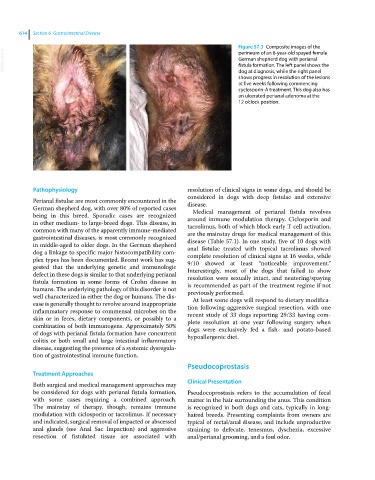Page 646 - Clinical Small Animal Internal Medicine
P. 646
614 Section 6 Gastrointestinal Disease
Figure 57.3 Composite images of the
VetBooks.ir German shepherd dog with perianal
perineum of an 8‐year‐old spayed female
fistula formation. The left panel shows the
dog at diagnosis, while the right panel
shows progress in resolution of the lesions
at five weeks following commencing
cyclosporin‐A treatment. This dog also has
an ulcerated perianal adenoma at the
12 o’clock position.
Pathophysiology resolution of clinical signs in some dogs, and should be
considered in dogs with deep fistulae and extensive
Perianal fistulae are most commonly encountered in the disease.
German shepherd dog, with over 80% of reported cases Medical management of perianal fistula revolves
being in this breed. Sporadic cases are recognized around immune modulation therapy. Ciclosporin and
in other medium‐ to large‐breed dogs. This disease, in tacrolimus, both of which block early T cell activation,
common with many of the apparently immune‐mediated are the mainstay drugs for medical management of this
gastrointestinal diseases, is most commonly recognized disease (Table 57.1). In one study, five of 10 dogs with
in middle‐aged to older dogs. In the German shepherd anal fistulae treated with topical tacrolimus showed
dog a linkage to specific major histocompatibility com- complete resolution of clinical signs at 16 weeks, while
plex types has been documented. Recent work has sug- 9/10 showed at least “noticeable improvement.”
gested that the underlying genetic and immunologic Interestingly, most of the dogs that failed to show
defect in these dogs is similar to that underlying perianal resolution were sexually intact, and neutering/spaying
fistula formation in some forms of Crohn disease in is recommended as part of the treatment regime if not
humans. The underlying pathology of this disorder is not previously performed.
well characterized in either the dog or humans. The dis- At least some dogs will respond to dietary modifica-
ease is generally thought to revolve around inappropriate tion following aggressive surgical resection, with one
inflammatory response to commensal microbes on the recent study of 33 dogs reporting 29/33 having com-
skin or in feces, dietary components, or possibly to a plete resolution at one year following surgery when
combination of both immunogens. Approximately 50% dogs were exclusively fed a fish‐ and potato‐based
of dogs with perianal fistula formation have concurrent hypoallergenic diet.
colitis or both small and large intestinal inflammatory
disease, suggesting the presence of a systemic dysregula-
tion of gastrointestinal immune function.
Pseudocoprostasis
Treatment Approaches
Both surgical and medical management approaches may Clinical Presentation
be considered for dogs with perianal fistula formation, Pseudocoprostasis refers to the accumulation of fecal
with some cases requiring a combined approach. matter in the hair surrounding the anus. This condition
The mainstay of therapy, though, remains immune is recognized in both dogs and cats, typically in long‐
modulation with ciclosporin or tacrolimus. If necessary haired breeds. Presenting complaints from owners are
and indicated, surgical removal of impacted or abscessed typical of rectal/anal disease, and include unproductive
anal glands (see Anal Sac Impaction) and aggressive straining to defecate, tenesmus, dyschezia, excessive
resection of fistulated tissue are associated with anal/perianal grooming, and a foul odor.

